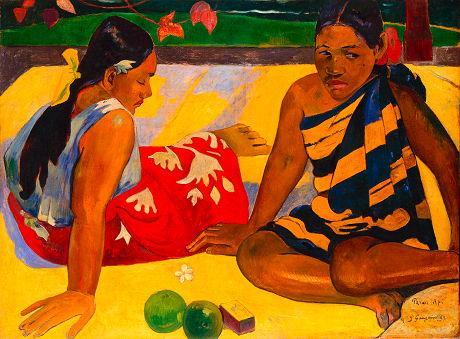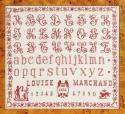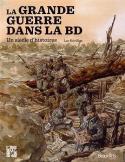Art Of The Day Weekly
#374 - from 5 February 2015 to 11 February 2015

Paul Gauguin, Parau api, 1892 (Quelles nouvelles ?), oil on canvas, 67 x 91 cm, Gemäldegalerie neue Meister, Staatliche Kunstsammlungen Dresden. Photo: Jürgen Karpinski
IN THE AIR
Gauguin, a misanthrope carried up in the clouds
BASEL – The aim of the exhibition is clear from the start. This event, prepared for six years, is the one that the Beyeler foundation has most invested in. So needless to say this presentation of fifty masterpieces by one of the most popular artists in the history of art will of course be one of the blockbusters of 2015. There is the introspective work of Gauguin in self-portraits as well as the side of the Nabi prophet of Pont-Aven. But his Tahiti period, the one his fans adore, the perpetual image of happy exoticism, is the one put forward this time. There are some remarkable loans from thirteen (an omen of good luck?) countries – and even from Russia at a time when relations are more than cooled off. The artist who barely managed to live from his art at the age of 52, in 1900, just before his death at the Marquises Islands, through the contract with Ambroise Vollard, would undoubtedly be surprised by this posthumous glory. How did a man who was unclassified, gruff, suffering from syphilis, anti-social (he was condemned several times for violence or insults to the administration), solitary (he abandoned his wife and his children in Europe and had various companions overseas), suicidal (with arsenic) and alcoholic, personify Eden? That is the power of art, capable of the miracle of transfiguration…
• Paul Gauguin at Fondation Beyeler, from 8 February to 28 May 2015.
EXHIBITIONS
The aesthetics of a tear
FRANKFURT - A long time ago there was the collage technique. Then came the anti-collage. That is what Jacques Villeglé and Raymond Hains dedicated themselves to one day in 1949, by slashing Parisian posters to take the remains, the material from their own work. These artists have no longer been considered for along time as vandals, but rather as artists in their own right (they were finally given recognition at the Paris Biennale in 1959). This retrospective focuses on five of them: aside from the two previous ones, the best known is Rotella, who is automatically associated to the atmosphere of the Roman Dolce vita from the sixties, with the faces of Mastroianni or Sofia Loren emerging from the slashed posters. Volf Vostell and, above all, Lettrist artist Dufrêne are not as well known. The latter is the most difficult to penetrate. Deep in his soul a poet, he preferred the back to the front of posters, he created palimpsests, the cousins of the cuneiform tablets and that convey a new language with indecipherable signs.
• Poetry of the Métropole. The Affichistes at the Schirn Kunsthalle, from 5 February to 25 May 2015.
Does art have a smell?
BASEL - In the art of the past it is impossible to talk of smells otherwise than in painting: images of fresh food, of wild game rotting or of a shepherdess smelling a flower. Contemporary art, with its installations and its use of technology has allowed this sense to enter our artistic emotions. Following the first trials by the Dada and Surrealist movements (their play on words Belle Haleine (Beautiful breath) by Marcel Duchamp and Man Ray), this practice became more complex. From Piero Manzoni’s Merda d’artista (carefully sealed in a tin but which curious millionaires will be able to open one day) to the works by Dieter Roth, impregnated with urine and pudding, we have reached the suspended elements of Ernesto Neto filled with spices or to Bill Viola’s videos projected through a steam smelling of eucalyptus. The exhibition draws up a situation that at moments is a review of the situation, and can sometimes be disturbing since it calls upon intimate or unbearable facts (mentioning the gas chambers).
• Belle haleine, l’odeur de l’art, at musée Tinguely, from 11 February to 17 May 2015.
AUCTIONS
Régine Deforges, a wise woman
PARIS – She was the High priest of erotic litterature (the companion of Jean-Jacques Pauvert and herself an editor, she reprinted in 1968 Aragon’s le Con d’Irène (Irene’s cunt), which was immediately forbidden) or as a popular novelist (la Bicyclette bleue). But she is hardly known for being a lover of paintings or of crochet. As her archives are scattered it will allow us to have a less monolithic image of Régine Deforges (1935-2014). Next to lots that illustrate the things she had a taste for and that everyone knows, – the Chansons badines by Charles Colle, the Joyeusetés galantes et autres du vidame Bonaventure de la Braguette by Albert Glatigny, autographed letters by Pierre Molinier or Bellmer), here are some unexpected embroideries. They are not very expensive works but they form a nice ensemble of popular art, of primers or of Saint Virgins praying from the XIXth century up to the works done by Régine Deforges herself. The secret gardens of authors are sometimes full of mysteries…
• Collection Régine Deforges 10 and 11 February 2015 at hôtel Drouot (PBA Associés)
ARTIST OF THE WEEK
Marlene Dumas, life and nothing else
While they have nothing to do with the provocative works by Topor, who in 1980 published in the Nouvel Observateur a drawing showing Christ getting ready to fornicate with a certain Lacrimachristi, the representations of Marie-Madeleine in the nude by Marlene Dumas (born 1953 in South Africa) could disturb the ultraconservatives in this period of antagonisms. These elegant inks on paper date back to 1996 but only for a side of this retrospective that shows the breadth of the artist's interests. The destruction caused by apartheid, the wars and conflicts, the mention of famous persons (Lady Di, Ben Laden, Naomi Campbell), the look of her own dughter, the sexclubs in Amsterdam… The whole thing is reinterpreted based on postcards, press cutouts, movie images, and is a remarkable human comedy of our time.
• Marlene Dumas, The Image as Burden at the Tate Modern, from 5 February to 10 May 2015.
BOOKS
WWI in comic-strip form
World War I in the form of comic strips: it can only be the work of Tardi (Putain de guerre !). Actually, as we can see in the compiled book illustrators, illustrators took over this means since the beginning of the conflict. Certain illustrated works such as la Croix d’honneur and la Jeune France were even created purposely by the powerful editors of the sector, the Offenstadt brothers, who own Cri-Cri and l’Épatant (the Superb). With les Pieds nickelés s’en vont en guerre, the infernal trio is armed, with the bottle of red wine in the pocket and we even see Bécassine mobilisée. While up to the seventies the tone was rather patriotic (for example, the heroic and moral ridden stories of Tintin or les Belles Histoires de l’oncle Paul published by Spirou), the speech is more critical with the appearance lof adult comic strips after 1968. Cabu got a real kick in writing and illustrating his A bas toutes les armées (1977) and Pat Mills creatd a monument in this type with Charley’s War (1979-86) which describes the daily life of a British soldier. The story of course continues: the most recent years see new graphic audacities and new types of scenarios and the fashion of adapting great novels such as le Feu by Barbusse.
• La Grande Guerre dans la BD, by Luc Révillon, Beaux Arts éditions, 2014, 240 p., €29.
IN BRIEF
BARCELONA – The new Museu de Cultures del Món (Museum of World Cultures) opens on 7 February 2015.
CAMBRIDGE – According to various specialists, the author of two statuettes of two nude men riding panthers and presented at the Fitzwilliam Museum as of 3 February 2015 would be Michel-Angelo, though he is known for no bronze pieces.
LONDON - Monet’s Le Grand Canal, painted in 1908, sold for £23.2 at Sotheby’s on 3 February 2015.
MEXICO – The modern and contemporary art fair Zona Maco is being held from 4 to 8 February 2015.
OPENINGS OF THE WEEK

Suzanne Lafont - SITUATIONS
6 February 2015 - NÎMES - Carré d'art
The artist (born 1949) experiments with the overwhelming material from contemporary image banks


